
Coupling (railway)
Encyclopedia
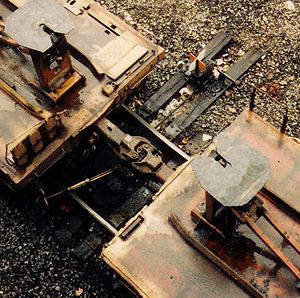
Rolling stock
Rolling stock comprises all the vehicles that move on a railway. It usually includes both powered and unpowered vehicles, for example locomotives, railroad cars, coaches and wagons...
in a train. The design of the coupler is standard, and is almost as important as the railway gauge, since flexibility and convenience are maximised if all rolling stock can be coupled together.
The equipment that connects the couplings to the rolling stock is known as the draft gear.
Nomenclature
The different types of coupling do not always have formal or official names, which makes descriptions of the couplings in use on any railway system problematic.Buffers and chain



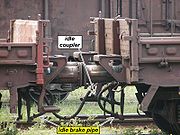
Planet (locomotive)
Planet was an early steam locomotive built in 1830 by Robert Stephenson and Company for the Liverpool and Manchester Railway. The ninth locomotive built for the L&MR, it was Stephenson's next major design change after the Rocket. It was the first locomotive to employ inside cylinders, and...
of the Liverpool and Manchester Railway
Liverpool and Manchester Railway
The Liverpool and Manchester Railway was the world's first inter-city passenger railway in which all the trains were timetabled and were hauled for most of the distance solely by steam locomotives. The line opened on 15 September 1830 and ran between the cities of Liverpool and Manchester in North...
of 1830. These couplings followed earlier tram
Tram
A tram is a passenger rail vehicle which runs on tracks along public urban streets and also sometimes on separate rights of way. It may also run between cities and/or towns , and/or partially grade separated even in the cities...
way practice but were made more regular. The vehicles are coupled by hand using a hook and links with a turnbuckle
Turnbuckle
A turnbuckle, stretching screw or bottlescrew is a device for adjusting the tension or length of ropes, cables, tie rods, and other tensioning systems. It normally consists of two threaded eyelets, one screwed into each end of a small metal frame, one with a left-hand thread and the other with a...
-like device that draws the vehicles together. In Britain, this is called a screw coupling. Vehicles have buffers
Buffer (rail transport)
A buffer is a part of the buffers-and-chain coupling system used on the railway systems of many countries, among them most of those in Europe, for attaching railway vehicles to one another....
, one at each corner on the ends, which are pulled together and compressed by the coupling device. This arrangement limits the slack in trains and lessens shocks. In contrast, Janney coupler
Janney coupler
The Janney coupler, also known as a knuckle coupler, buckeye coupler, alliance coupler and AAR coupler is an automatic coupler patented by Eli H...
s encourage comparatively violent encounters in order to engage the coupling fully. The earliest buffers were fixed extensions of the wagon frames, but later spring buffers were introduced.
Inefficient and slow, the European system is relatively unsafe because it requires manual coupling between vehicles, exposing workers to the risk of being crushed. However, there is no need for the worker to go between vehicles while they are moving, which is an improvement over the link-and-pin types.
This coupling type is the standard in European countries (except the former Soviet Union, where the SA-3 automatic coupler
SA3 coupler
The SA3 coupler is a type of railway coupling used mainly, but not exclusively, in Russia and other states of the former Soviet Union.Railways in Russia used European buffers and couplings from their inception. These couplings had three main limitations. Firstly the load was limited. Secondly, the...
is used). Coupling is done by a worker, who must climb between the cars. First he turns a releasing screw (an aid with two opposite windings, and it does not uncouple the train itself) to the loose position, and then he can hang the chain on the hook. After hanging the chain on the towing hook the releasing screw must be turned to the tight position. When the coupler is uncoupled, it must be hung on the idle hook to prevent damage to itself or the brake pipes. Only shunting is permitted with a dangling chain. Disconnected brake pipes must be hung on hooks. (The picture shows two coupled cars, with a single brake pipe.)
The hooks and chain hold the carriages together, while the buffers keep the carriages from banging into each other so that no damage is caused. The buffers can be "dumb" or spring-loaded. That means there are no run-in forces on the coupler. The other benefit compared with automatic couplers is that its lesser slack causes smaller forces on curves; there is a lower probability of a broken coupler in a curve than with automatic couplers. The disadvantage is the smaller mass of the freight that can be hauled by that coupler (maximum 3000 t (2,953 LT; 3,307 ST)).
Early rolling stock was often fitted with a pair of auxiliary chains as a backup if the main coupling failed. This made sense before the fitting of continuous fail-safe braking systems.
On railways where rolling stock always pointed the same way, the chain might be mounted at one end only, as a small cost- and weight-saving method.
On German
Rail transport in Germany
, Germany had a railway network of 41,315 km. 19,857 km are electrified. The total track length was 76,473 km. Germany is a member of the International Union of Railways . The UIC Country Code for Germany is 80.-Overview:...
and Scandinavian railways, the left buffer is flatter than the right one, which is slightly more rounded. This provides better contact between the buffers than would be the case if both buffers were slightly rounded.
Three-link couplings
A peculiarly British institution was the "loose-coupled" freight train. This used three-link chain couplings with no means of drawing the wagons together: since such trains were not fitted with an automatic through-train braking system there were no pipes to connect between the vehicles. The couplings in the train were kept taut by the last vehicle of the train being a heavily ballasted guard's van with its brakes set slightly on. This helped prevent snapped couplings. Such trains travelled at low speeds and were phased out in the 1970s.An improvement on this is the "Instanter" coupling, in which the middle link of a three link chain is specially shaped so that when lying "prone" it provides enough slack to make coupling possible, but when this middle link is rotated 90 degrees the length of the chain is effectively shortened, reducing the amount of slack without the need to wind a screw. The closeness of the coupling allows the use of inter-vehicle pipes for train brakes. It also has the advantage that it can be operated entirely from the side of the wagons using a shunter's pole and is therefore safer when shunting work is under way. These couplings are still prevalent in UK freight trains today.
Center-buffer-and-chain(s)

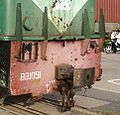

Europe
Europe is, by convention, one of the world's seven continents. Comprising the westernmost peninsula of Eurasia, Europe is generally 'divided' from Asia to its east by the watershed divides of the Ural and Caucasus Mountains, the Ural River, the Caspian and Black Seas, and the waterways connecting...
a simplified version is used, consisting of a single central buffer with a chain underneath. Sometimes there are two chains, one on each side of the coupler. The chain usually contains a screw-adjustable link to allow close coupling. These variants are also used elsewhere. On sharp curves, a single centre buffer is less likely to be subject to buffer-locking.
Buffers-and-chain on the narrow gauge
Perhaps because of the buffer-locking problem occasioned by sharp curves – and Carl Pihl's successful promotion of the single-buffer Norwegian couplerNorwegian coupling
A Norwegian coupling or meat chopper is a manual coupling consisting of a central buffer with a mechanical hook that drops into a slot in the central buffer...
that he designed to overcome this – conventional buffers-and-chain coupling is rarely employed on narrow-gauge systems: notable exceptions being the railway networks of Senegal
Rail transport in Senegal
Senegal has 906 km of railway at gauge. This is part of the Dakar-Niger Railway which crosses the border to Mali. The railway is operated by Transrail, managed by the Belgian company Vecturis.- History :...
/Mali
Rail transport in Mali
Mali has only one railway, the Dakar-Niger Railway, which includes 729 kilometers in Mali and runs from the port of Koulikoro via Bamako to the border with Senegal and continues on to Dakar...
and Côte d'Ivoire
Rail transport in Côte d'Ivoire
Côte d'Ivoire has 660 kilometres of railway . The track gauge is .In October 2010, the government announced plans to build a 737km line which would link the port of San Pedro to mines in the west of the country....
/Burkina Faso
Rail transport in Burkina Faso
There are 622 kilometres of gauge railway in Burkina Faso, of which 517 km run from Ouagadougou to Abidjan in Côte d'Ivoire; and 105 km from Ouagadougou to Kaya.Burkina Faso is landlocked; the railway to Abidjan provides access to the sea....
in Africa, and Queensland
Rail transport in Queensland
Rail transport in Queensland began in 1865. Today it is one of the largest narrow gauge railway network in the world.-Public float:On 2 June 2009 the Queensland Government announced the 'Renewing Queensland Plan', with Queensland Rail's commercial activities to be separated from the Government's...
and Tasmania
Rail transport in Tasmania
Rail transport in Tasmania consists of a network of narrow gauge track of reaching virtually all cities and major towns in the island state of Tasmania, Australia. Today, rail services are focussed primarily on bulk freight, with no commercial passenger services being operated...
in Australia.
Buffer-locking
The buffers and chain coupling system has a maximum load much less than that of the Janney coupling. Also, on sharp reverse curves, the buffers can get buffer-locked by slipping over – and onto the back of – an adjacent buffer. Although careful track design makes this occurrence rare, an accident at a Swiss station in the 1980s was caused by buffer-locked wagons. Buffer-lock could be caused on the very sharp turnouts by the older, rounded buffers. The newer buffers are rectangular and they are wider than they are tall. They are not so flat, so they rarely cause buffer-locking.Variation with gauge
The width between the buffers tends to increase as the gauge increases or decrease as the gauge decreases, so that if wagons are changed from one gauge to another, the buffers will no longer match. This occurs because the buffers are originally extensions of the frames, which are spaced according to the gauge. Conversely, as gauge reduces, the distance between the buffers reduces also. The height of the buffers is usually lower on narrow gauge railways, corresponding to the generally lower height of the rolling stock.Dimensions
Dimensions showing variation by gauge.- Standard gauge - England
- Height: 3 foot
- Separation: 6 ft (1,829 mm)
- Metre gauge - Senegal/Mali Jane's World Railways 1969 - 1970 edition
- Height: 29+3/4 in
- Separation: 49+1/8 in
Link and pin

The link-and-pin coupler consisted of a tubelike body that received an oblong link. During coupling, a railworker had to stand between the cars as they came together and guide the link into the coupler pocket. Once the cars were joined, the employee inserted a pin into a hole a few inches from the end of the tube to hold the link in place. This procedure was exceptionally dangerous and many brakemen lost fingers or entire hands when they did not get their hands out of the way of the coupler pockets; many more were killed as a result of being crushed between cars or dragged under cars that were coupled too quickly. Brakemen were issued with heavy clubs that could be used to hold the link in position, but many brakemen would not use the club, and risk injury.
The link-and-pin coupler proved unsatisfactory because:
- It made a loose connection between the cars, with too much slack actionSlack actionIn railroading, slack action is the amount of free movement of one car before it transmits its motion to an adjoining coupled car. This free movement results from the fact that in railroad practice cars are loosely coupled, and the coupling is often combined with a shock-absorbing device, a "draft...
.
- There was no standard design, and train crews often spent hours trying to match pins and links while coupling cars.
- The links and pins were often pilfered (due to their value as scrap metal), resulting in substantial replacement costs. John H. White suggests that the railroads considered this to be more important than the safety issue at the time (see reference below).
- Crew members had to go between moving cars during coupling, and were frequently injured and sometimes killed.
- Eventually, railroads wished to operate trains that were heavier than the link-and-pin system could cope with.
An episode of the 1960s TV series Casey Jones
Casey Jones (TV series)
Casey Jones is an American children's Western series that ran during the '58-'59 television season, based around the pioneering western railroads. The series aired in syndication in the United States...
was devoted to the problems of link-and-pin couplings.
The Miller Hook and Platform
The link and pin was replaced in U.S. passenger car usage during the latter part of the 19th century by the assemblage known as the Miller PlatformMiller Platform
The Miller Platform was an innovative railroad passenger car platform of the 19th century designed to prevent the hazard of telescoping in railroad collisions. It was named for its U.S. inventor, Ezra Miller who was issued a patent for it on July 24, 1866...
, which included a new coupler called the Miller Hook. The Miller Platform (and hook coupler) was used for several decades before being replaced by the Janney coupler.
Norwegian
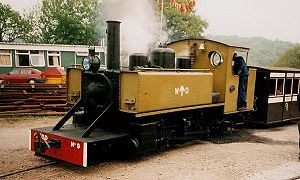
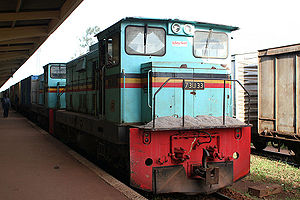
Western Australian Government Railways
Western Australian Government Railways was most common name of the Western Australian government rail transport authority from 1890 to 1976. It is, in its current form, known as the Public Transport Authority of Western Australia....
, the Ffestiniog Railway
Ffestiniog Railway
The Ffestiniog Railway is a narrow gauge heritage railway, located in Gwynedd, Wales. It is a major tourist attraction located mainly within the Snowdonia National Park....
and the Welsh Highland Railway
Welsh Highland Railway
The Welsh Highland Railway is a long restored narrow gauge heritage railway in North Wales, operating from Caernarfon to Porthmadog, and passing through a number of popular tourist destinations including Beddgelert and the Aberglaslyn Pass. At Porthmadog it connects with the Ffestiniog Railway...
, where low speeds and reduced train loads allow a simpler system. New Zealand Government Railways, during the 1970s, developed an extremely large and heavy-duty version of the chopper coupler. These were first applied to a fleet of DX class
NZR DX class
The NZR DX class is a class of 49 Co-Co diesel-electric locomotives that currently operates on New Zealand's national railway network.Built by General Electric in Erie, Pennsylvania, United States, they were introduced to New Zealand between 1972 and 1976. The class is based on the General Electric...
GE locomotives that had arrived from the U.S. with auto couplers, however they were converted once it was decided that these locomotives would operate on other than just the North Island Main Trunk express freight trains. On railway lines where rolling stock always points the same way, the mechanical hook may be provided only on one end of each wagon. This was the situation on the Lynton & Barnstaple
Lynton and Barnstaple Railway
The Lynton & Barnstaple Railway opened as an independent railway in May 1898. It was a single track narrow gauge railway slightly over long running through the rugged and picturesque area bordering Exmoor in North Devon, England. Although opened after the 1896 Light Railways Act came into force,...
(L&B), a narrow gauge line in Devon
Devon
Devon is a large county in southwestern England. The county is sometimes referred to as Devonshire, although the term is rarely used inside the county itself as the county has never been officially "shired", it often indicates a traditional or historical context.The county shares borders with...
, England
England
England is a country that is part of the United Kingdom. It shares land borders with Scotland to the north and Wales to the west; the Irish Sea is to the north west, the Celtic Sea to the south west, with the North Sea to the east and the English Channel to the south separating it from continental...
, and still applies to railways in New Zealand
New Zealand
New Zealand is an island country in the south-western Pacific Ocean comprising two main landmasses and numerous smaller islands. The country is situated some east of Australia across the Tasman Sea, and roughly south of the Pacific island nations of New Caledonia, Fiji, and Tonga...
. Similarly, the hand brake handles may also be on one side of the wagons only.
Norwegian couplings are not particularly strong, and may be supplemented by auxiliary chains. The L&B originally used side chains in conjunction with Norwegian couplers, but these were found to be unnecessary with the slow speeds employed (10 –) and were removed within a year or so of the line opening in 1898.
The Pichi Richi Railway
Pichi Richi Railway
The Pichi Richi Railway Preservation Society is a non-profit railway preservation society and operating museum formed in 1973. The society, managed and staffed by volunteers, operates heritage steam and diesel trains on the restored 39 km section of track between Quorn and Port Augusta in...
in South Australia
South Australia
South Australia is a state of Australia in the southern central part of the country. It covers some of the most arid parts of the continent; with a total land area of , it is the fourth largest of Australia's six states and two territories.South Australia shares borders with all of the mainland...
uses Norwegian couplers as its standard, and converts Janney coupler to Norwegian as required. The slot in the "buffer beam" where the coupler protrudes appears to be about the same for both types of couplers. As a museum, it is appropriate to use the older type of coupling.
Not all Norwegian couplings are compatible with one another as they vary in height, width, and may or may not be limited to one hook at a time.
Automatic couplers
There are a number of automatic train couplings, most of which are mutually incompatible.Janney (AAR) coupler
Later Master Car Builders Association coupler, now AAR (Association of American RailroadsAssociation of American Railroads
The Association of American Railroads is an industry trade group representing primarily the major freight railroads of North America . Amtrak and some regional commuter railroads are also members...
) coupler; also known as knuckle coupler and alliance coupler.
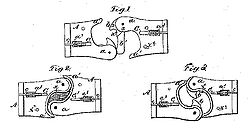
Eli H. Janney
Eli H. Janney , aka Eli Hamilton Janney or simply Eli Janney, was the inventor of the modern knuckle coupler that replaced link and pin couplers on North American railroads....
, who received a patent
Patent
A patent is a form of intellectual property. It consists of a set of exclusive rights granted by a sovereign state to an inventor or their assignee for a limited period of time in exchange for the public disclosure of an invention....
in 1873 . It is also known as a "buckeye coupler", notably in the United Kingdom
United Kingdom
The United Kingdom of Great Britain and Northern IrelandIn the United Kingdom and Dependencies, other languages have been officially recognised as legitimate autochthonous languages under the European Charter for Regional or Minority Languages...
, where some rolling stock (mostly for passenger trains) is fitted with it. Janney was a dry goods clerk and former Confederate Army officer from Alexandria, Virginia
Alexandria, Virginia
Alexandria is an independent city in the Commonwealth of Virginia. As of 2009, the city had a total population of 139,966. Located along the Western bank of the Potomac River, Alexandria is approximately six miles south of downtown Washington, D.C.Like the rest of northern Virginia, as well as...
, who used his lunch hours to whittle from wood an alternative to the link and pin coupler. The term Buckeye comes from the nickname of the US state of Ohio
Ohio
Ohio is a Midwestern state in the United States. The 34th largest state by area in the U.S.,it is the 7th‑most populous with over 11.5 million residents, containing several major American cities and seven metropolitan areas with populations of 500,000 or more.The state's capital is Columbus...
, the "Buckeye state" and the Ohio Brass Company which originally marketed the coupling.
In 1893, satisfied that an automatic coupler could meet the demands of commercial railroad operations and, at the same time, be manipulated safely, the United States Congress
United States Congress
The United States Congress is the bicameral legislature of the federal government of the United States, consisting of the Senate and the House of Representatives. The Congress meets in the United States Capitol in Washington, D.C....
passed the Safety Appliance Act. Its success in promoting switchyard safety was stunning. Between 1877 and 1887, approximately 38% of all railworker accidents involved coupling. That percentage fell as the railroads began to replace link and pin couplers with automatic couplers. By 1902, only two years after the SAA's effective date, coupling accidents constituted only 4% of all employee accidents. Coupler-related accidents dropped from nearly 11,000 in 1892 to just over 2,000 in 1902, even though the number of railroad employees steadily increased during that decade.
When the Janney coupling was chosen to be the American standard, there were 8,000 patented alternatives to choose from. The only significant disadvantage of using the AAR (Janney) design is that sometimes the drawheads need to be manually aligned.
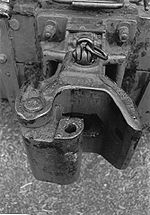
Rail transport in Canada
Canada has a large and well-developed railway system that today transports primarily freight. There are two major privately owned transcontinental freight railway systems, the Canadian National and Canadian Pacific Railway. Nation-wide passenger services are provided by the federal crown...
, the United States
Rail transport in the United States
Presently, most rail transport in the United States is based on freight train shipments. The U.S. rail industry has experienced repeated convulsions due to changing U.S. economic needs and the rise of automobile, bus, and air transport....
, Mexico
Rail transport in Mexico
Mexico has a freight railway system that is privately owned and extends across most of the country, connecting major industrial centers with ports and with rail connections at the United States border...
, Japan
Rail transport in Japan
Rail transport in Japan is a major means of passenger transport, especially for mass and high-speed travel between major cities and for commuter transport in metropolitan areas.-Overview:...
, Australia
Rail transport in Australia
Rail transport in Australia is a crucial aspect of the Australian transport network, and an enabler of the wider Australian economy. Rail in Australia is to a large extent state-based. The Australian rail network consists of a total of 41,461 km of track of three major gauges, of which...
, South Africa
Rail transport in South Africa
Rail transport in South Africa is the most important element of the country's transport infrastructure. All major cities are connected by rail, and South Africa's railway system is the most highly developed in Africa...
, Saudi Arabia
Rail transport in Saudi Arabia
The Saudi Railways Organization provides freight services on two main lines totalling 1018 km. These connect Riyadh with the Persian Gulf port of Dammam...
, Cuba, Chile, Brazil
Rail transport in Brazil
Rail transport in Brazil began in the 19th century and there were many different railway companies. The railways were nationalised under RFFSA in 1957...
, China
Rail transport in the People's Republic of China
Rail transport is the most commonly used mode of long-distance transportation in the People's Republic of China. Almost all rail operations are handled by the Ministry of Railways, which is part of the State Council of the People's Republic of China...
and elsewhere. Among its features:
- Maximum tonnage as high as 32000 tonnes (70,547,923.9 lb) such as on the Fortescue Railway.
- Minimum Ultimate Tensile Strength:
- Grade E Knuckles:650000 pound-forces (2.9 MN)
- Only Grade C or Grade E Knuckles are permissible in interchange service.
- Grade E Coupler Bodies:900000 pound-forces (4 MN)
- Grade E Knuckles:650000 pound-forces (2.9 MN)
- Many AAR Coupler designs exist to accommodate requirements of various car designs, but all are required to have certain dimensions in common which allow for one design to couple to any other.
- Lighter weight railways, especially those of narrow gauge or with no need for Interchange (freight rail)Interchange (freight rail)In freight rail transport, interchange is the practice of railroads conveying freight cars from other companies over their lines...
sometimes use smaller (three-quarter- or half-size) versions of the AAR coupling.
- Lighter weight railways, especially those of narrow gauge or with no need for Interchange (freight rail)
- AAR couplers are always right-handed.
- Required Coupler Heights
- Empty Cars: 33.5 inches (851 mm) +/- 1 inches (25.4 mm)
- Loaded Cars: 32.5 inches (826 mm) +/- 1 inches (25.4 mm)
- AAR couplers are uncoupled by lifting the coupling pin with a lever at the corner of the car. This pin is locked when the coupler is under tension, so the usual uncoupling steps are to compress the coupling with a locomotive, lift and hold up the pin, then pull the cars apart. Side operated variants are called the "Sharon coupler" or "Buckeye coupler".
- Trains fitted with AAR couplers can accommodate heavier loads than any other type of coupler. Thus the heaviest coal trains in New ZealandNew ZealandNew Zealand is an island country in the south-western Pacific Ocean comprising two main landmasses and numerous smaller islands. The country is situated some east of Australia across the Tasman Sea, and roughly south of the Pacific island nations of New Caledonia, Fiji, and Tonga...
have AAR couplings even though the remainder of the fleet has the "meat chopperNorwegian couplingA Norwegian coupling or meat chopper is a manual coupling consisting of a central buffer with a mechanical hook that drops into a slot in the central buffer...
" kind. Also, long-distance freight trains in North AmericaNorth AmericaNorth America is a continent wholly within the Northern Hemisphere and almost wholly within the Western Hemisphere. It is also considered a northern subcontinent of the Americas...
are commonly more than 1 miles (1.6 km) long, whereas this is not seen in EuropeEuropeEurope is, by convention, one of the world's seven continents. Comprising the westernmost peninsula of Eurasia, Europe is generally 'divided' from Asia to its east by the watershed divides of the Ural and Caucasus Mountains, the Ural River, the Caspian and Black Seas, and the waterways connecting...
, where most freight trains still use the buffers and chain system.
Changes since 1873

- The current AAR contour dates back to the Master Car Builders Association (MCBA) coupler.
- Buckeye coupler, a side operated version of the MCBA coupler
- Type "E" coupler, the original (plain) AAR coupler, derived from the Master Car Builders Association coupler.
- Type "F" coupler, a "tooth and socket" or "tightlock" variation to prevent accidents, derailments and wrecks from uncoupling the couplers. The "tooth" on a loose coupler could puncture any tank carTank carA tank car is a type of railroad rolling stock designed to transport liquid and gaseous commodities.-Timeline:...
or other car carrying hazardous materials. Variations on the AAR type "F" coupler have been devised to provide extra protection, in case of derailments and train wrecks, to cars routinely carrying sensitive or hazardous loads. These variations of type "F" couplers, generally involving "shelves", remain fully compatible with standard AAR couplers, but tend to keep derailments and collisions from uncoupling the cars (thereby preventing the "tooth" of the couplers from piercing the ends of the cars).
- The APTA (former AAR) standard type "H" coupler, a "tooth and socket" or "tightlock" variation used mostly, if not exclusively, on passenger cars. The Type "H" coupler is now under the supervision of the APTA (American Public Transportation AssociationAmerican Public Transportation AssociationThe American Public Transportation Association is a non-profit organization which serves as an advocate for the advancement of public transportation programs and initiatives in the United States. Since its founding in 1882, APTA has educated the public about the benefits of public transportation...
)
- Types "F" and "H" couplers are also known as tightlock couplingTightlock couplingTightlock coupling or titelok coupler is an Association of American Railroads tooth and toothbrush automatic coupler of which there are two types:...
s.
- "pads" to reduce slack on passenger trains.
- improvement to castings, etc. to increase maximum trailing load.
- rotating-shaft couplers (type "F") introduced for use in rotary car dumperRotary car dumperA rotary car dumper or wagon tippler is a mechanism used for unloading certain railroad cars such as hopper cars, gondolas or lorries . It holds the rail car to a section of track and rotates the track and car together to dump out the contents. Used with gondola cars, it is making open hopper cars...
s such as on the Pilbara railways.
- narrow gauge railways such as the VictorianVictoria (Australia)Victoria is the second most populous state in Australia. Geographically the smallest mainland state, Victoria is bordered by New South Wales, South Australia, and Tasmania on Boundary Islet to the north, west and south respectively....
Puffing Billy Railway use a miniature version of the AAR coupler.
SA3 coupler
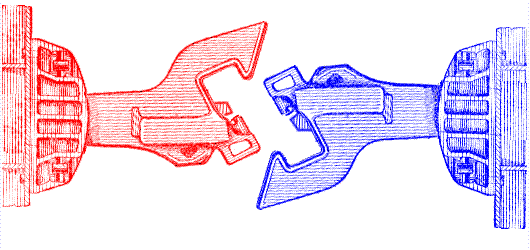
Russia
Russia or , officially known as both Russia and the Russian Federation , is a country in northern Eurasia. It is a federal semi-presidential republic, comprising 83 federal subjects...
n SA3 coupler works according to the same principles as the AAR coupler but is incompatible, it was introduced during the rebuilding of the railway network in Soviet Union
Soviet Union
The Soviet Union , officially the Union of Soviet Socialist Republics , was a constitutionally socialist state that existed in Eurasia between 1922 and 1991....
after the Second World War
World War II
World War II, or the Second World War , was a global conflict lasting from 1939 to 1945, involving most of the world's nations—including all of the great powers—eventually forming two opposing military alliances: the Allies and the Axis...
and have since been used on the whole broad gauge network, including Finland
Finland
Finland , officially the Republic of Finland, is a Nordic country situated in the Fennoscandian region of Northern Europe. It is bordered by Sweden in the west, Norway in the north and Russia in the east, while Estonia lies to its south across the Gulf of Finland.Around 5.4 million people reside...
and Mongolia
Mongolia
Mongolia is a landlocked country in East and Central Asia. It is bordered by Russia to the north and China to the south, east and west. Although Mongolia does not share a border with Kazakhstan, its western-most point is only from Kazakhstan's eastern tip. Ulan Bator, the capital and largest...
. It is also used on the standard gauge networks of Iraq
Iraq
Iraq ; officially the Republic of Iraq is a country in Western Asia spanning most of the northwestern end of the Zagros mountain range, the eastern part of the Syrian Desert and the northern part of the Arabian Desert....
and on Malmbanan
Malmbanan
The Iron Ore Line is a long railway line between Riksgränsen and Boden in Norrbotten County, Sweden. The line contains two branches, from Kiruna to Svappavaara and from Gällivare to Koskullskulle. The term is often colloquially used to also include the Ofoten Line, from Riksgränsen to Narvik in...
in Sweden
Sweden
Sweden , officially the Kingdom of Sweden , is a Nordic country on the Scandinavian Peninsula in Northern Europe. Sweden borders with Norway and Finland and is connected to Denmark by a bridge-tunnel across the Öresund....
for ore trains.
- Russian trains are rarely longer than about 750 m (2,460.6 ft) and rarely exceed a maximum tonnage of about 6000 t (13,227,735.7 lb), so it is not clear what potential load these couplings are capable of. The trains on MalmbananMalmbananThe Iron Ore Line is a long railway line between Riksgränsen and Boden in Norrbotten County, Sweden. The line contains two branches, from Kiruna to Svappavaara and from Gällivare to Koskullskulle. The term is often colloquially used to also include the Ofoten Line, from Riksgränsen to Narvik in...
are about 8000 t (17,636,981 lb). - The force to break the SA-3 coupler is about 300 tonnes-force (2.9 MN; 660,000 lbf).
- The maximum allowed tractive effort to the SA-3 is limited to 135 tonnes-force (1.32 MN; 298,000 lbf) by Russian white papers.
- The proposed European automatic coupler is compatible with the Russian coupler but with automatic air, control and power connections. Implementation is permanently delayed except for a few users. See Europe below.
- The SA3 resembles a left-handed fist.
Unicoupler/Intermat
Unicoupler has been developed by Knorr companyKnorr-Bremse
Knorr-Bremse is a manufacturer of braking systems for rail and commercial vehicles that has operated in the field for over 100 years. The company also produces door systems for rail vehicles and torsional dampers. In 2009, the Group's workforce of over 14,000 achieved worldwide sales of EUR 2.761...
from Germany in the 1970s and is widely used in Iran in freight cars.
this type of coupler is compatible with SA-3 and Willison couplers. The Unicoupler is also known as AK69e.
The Unicoupler was the West-European development, it was developed in parallel with a compatible East-European couterpart, the Intermat coupler.
C-AKv
The C-AKvC-AKv
The C-AKv coupler is a fully automatic center coupler for railway cars, which is designed as a replacement for the European buffers-and-chain coupler. Its profile is based on the Willison profile of the Russian SA3 coupler...
coupler is a newer compact Willison coupler developed by Faiveley Transport. It is mechanical fully compatible to the SA-3 coupler and the Unicoupler and if additional buffers are mounted it can be coupled with the conventional European screw coupling too.
Other
- Scharfenberg coupler used on electric passenger trains - connects brake and controls. See Fully Automatic Couplings below.
- Maximum tonnage under 1000 t (1,102.3 ST; 984.2 LT).
Multi-Function Couplers
MFCs are 'fully automatic' couplers that make all connections between the rail vehicles (mechanical, air brake and electrical) without human intervention, in contrast to autocouplers which just handle the mechanical aspects. The majority of trains fitted with these types of couplers are multiple units, especially those used in mass transit operations.There are a few designs of fully automatic couplers in use worldwide, including the Scharfenberg coupler, various knuckle hybrids (such as the Tightlock, used in the UK), the wedgelock coupling, Dellner couplings (similar to Scharfenberg couplers in appearance), BSI coupling (now Faiveley Transport) and the Schaku-Tomlinson Tightlock coupling.
There are a number of other automatic train couplings similar to the Scharfenberg coupler, but not necessarily compatible with it. Older US transit operators continue to use these non-Janney electro-pneumatic coupler designs and have used them for decades.
Westinghouse H2C MU coupler
The WestinghouseWestinghouse Air Brake Company
The railway air brake was invented by George Westinghouse of New York state in 1869. Soon after, he moved to Pittsburgh, Pennsylvania, where he established the Westinghouse Air Brake Company on September 28, 1869...
H2C coupler is currently used on the R62, R62A, R68, R68A, R42 and R32 class subway cars of New York City Subway. The A ends of the cars typically have the Westinghouse coupler and the B ends use either a semi-permanent drawbar, or a Westinghouse coupler.
Scharfenberg coupler
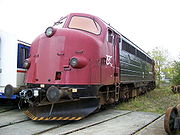

Kaliningrad
Kaliningrad is a seaport and the administrative center of Kaliningrad Oblast, the Russian exclave between Poland and Lithuania on the Baltic Sea...
), it has gradually spread from transit trains to regular passenger service trains, although outside Europe its use is generally restricted to mass transit systems. The Schaku coupler is superior in many ways to the AAR (Janney/Knuckle) coupler because it makes the electrical and also the pneumatic connections and disconnections automatic. However there is no standard for the placement of these electro-pneumatic connections. Some rail companies have them placed on the sides while others have them placed above the mechanical portion of the Schaku coupler. The main disadvantage to the Scharfenberg coupler is its low maximum tonnage, which makes it unsuitable for freight operations.
Small air cylinders, acting on the rotating heads of the coupler, ensure the Schaku coupler engagement, making it unnecessary to use shock to get a good coupling. Joining portions of a passenger train can be done at very low speed (less than 2 mph (0.89408 m/s) in the final approach), so that the passengers are not jostled about. Rail equipment manufacturers such as Bombardier
Bombardier Transportation
Bombardier Transportation is the rail equipment division of the Canadian firm, Bombardier Inc. Bombardier Transportation is one of the world's largest companies in the rail-equipment manufacturing and servicing industry. Its headquarters are in Berlin, Germany....
offer the Schaku coupler as an option on their mass transit systems and their passenger cars and locomotives. In North America
North America
North America is a continent wholly within the Northern Hemisphere and almost wholly within the Western Hemisphere. It is also considered a northern subcontinent of the Americas...
all the trains of the Montreal Metro
Montreal Metro
The Montreal Metro is a rubber-tired metro system, and the main form of public transportation underground in the city of Montreal, Quebec, Canada....
are equipped with it, as are new light rail systems in Denver
TheRide
RTD Bus & Light Rail is a transit system in the Denver, Colorado metropolitan area. It is operated by the Regional Transportation District . It currently operates 101 local, 13 limited, 24 express, 16 regional, and 6 skyRide bus routes...
, Baltimore
Baltimore Light Rail
The Maryland Transit Administration Light Rail is a light rail system serving Baltimore, Maryland, United States, and the surrounding suburbs.In downtown Baltimore it uses city streets...
and New Jersey
New Jersey Transit
The New Jersey Transit Corporation is a statewide public transportation system serving the United States state of New Jersey, and New York, Orange, and Rockland counties in New York State...
. It is also used on light rail
Light rail
Light rail or light rail transit is a form of urban rail public transportation that generally has a lower capacity and lower speed than heavy rail and metro systems, but higher capacity and higher speed than traditional street-running tram systems...
vehicles in Portland, Minneapolis
Hiawatha Line
The Hiawatha Line is a light rail corridor in Hennepin County, Minnesota that extends from downtown Minneapolis to the southern suburb of Bloomington. It was formerly known as the Hiawatha Line named after Hiawatha Avenue. Major connections on the line include the Minneapolis-St...
, the Vancouver Skytrain
SkyTrain (Vancouver)
SkyTrain is a light rapid transit system in Metro Vancouver, British Columbia, Canada. SkyTrain has of track and uses fully automated trains on grade-separated tracks, running mostly on elevated guideways, which helps SkyTrain to hold consistently high on-time reliability...
, and the Scarborough RT in Toronto
Toronto
Toronto is the provincial capital of Ontario and the largest city in Canada. It is located in Southern Ontario on the northwestern shore of Lake Ontario. A relatively modern city, Toronto's history dates back to the late-18th century, when its land was first purchased by the British monarchy from...
. It also equips all the dedicated rolling stock used for the shuttle services in the Channel Tunnel
Channel Tunnel
The Channel Tunnel is a undersea rail tunnel linking Folkestone, Kent in the United Kingdom with Coquelles, Pas-de-Calais near Calais in northern France beneath the English Channel at the Strait of Dover. At its lowest point, it is deep...
.
- Maximum tonnage under 1000 t (1,102.3 ST; 984.2 LT).
United Kingdom
Due to the rush to dieselise and electrify, the United Kingdom ended up with a variety of incompatible couplings and electrical connections. The latter were categorised as yellow triangle, blue square, and so on. This has nothing to do with the physical connection of vehicles. Coupling Codes, as they were known, only became relevant if multiple working of locomotives or Multiple Units was required.Dual couplings and match wagons
If a wagon with one coupling system needs to be coupled to wagons with another coupling type there are two solutions. This may be needed when taking metroRapid transit
A rapid transit, underground, subway, elevated railway, metro or metropolitan railway system is an electric passenger railway in an urban area with a high capacity and frequency, and grade separation from other traffic. Rapid transit systems are typically located either in underground tunnels or on...
rolling stock from its manufacturer to the city where it is to be used:
- use a match wagon(s) which has different couplings at either end.
- use a coupling adaptor (such as illustrated).
Only some kinds of couplings coexist on the end of a wagon at the same time, because amongst other reasons they need to be at the same height. For example, in the Australia
Australia
Australia , officially the Commonwealth of Australia, is a country in the Southern Hemisphere comprising the mainland of the Australian continent, the island of Tasmania, and numerous smaller islands in the Indian and Pacific Oceans. It is the world's sixth-largest country by total area...
n state of Victoria
Victoria (Australia)
Victoria is the second most populous state in Australia. Geographically the smallest mainland state, Victoria is bordered by New South Wales, South Australia, and Tasmania on Boundary Islet to the north, west and south respectively....
, engines had the AAR coupler, with buffers, and the chain mounted on a lug cast into the AAR coupler.
A match wagon or match truck (also known as a barrier vehicle / wagon in Britain and Transition Car in the United States) has different kinds of couplings at each end. If a pair of match wagons is used, a rake of wagons using coupling A can be inserted into a train otherwise using coupling B.
A coupling adaptor or compromise coupler might couple to an AAR coupling on a wagon, and present, for example, a meatchopper coupler or rapid transit coupler to the next wagon. Such an adaptor might weigh 100 kg (220.5 lb).
Dual coupling
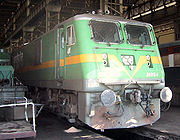
Locomotives and some freight cars of the Indian Railways
Indian Railways
Indian Railways , abbreviated as IR , is a departmental undertaking of Government of India, which owns and operates most of India's rail transport. It is overseen by the Ministry of Railways of the Government of India....
are fitted with a 'transition coupler' that incorporates a screw coupling within a knuckle coupler: the knuckle coupler remains in position and does not swing away when not in use. The screw coupling is mounted on a hinge
Hinge
A hinge is a type of bearing that connects two solid objects, typically allowing only a limited angle of rotation between them. Two objects connected by an ideal hinge rotate relative to each other about a fixed axis of rotation. Hinges may be made of flexible material or of moving components...
on the opposite side of the knuckle coupler. Most Indian freight cars use the knuckle coupler alone, without buffers, whereas passenger coaches almost exclusively use screw couplers and buffers. Exceptions are the new LHB coaches imported from Europe, and a few other makes of carriages converted to use knuckle couplers
Tightlock coupling
Tightlock coupling or titelok coupler is an Association of American Railroads tooth and toothbrush automatic coupler of which there are two types:...
.
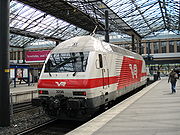
SA3 coupler
The SA3 coupler is a type of railway coupling used mainly, but not exclusively, in Russia and other states of the former Soviet Union.Railways in Russia used European buffers and couplings from their inception. These couplings had three main limitations. Firstly the load was limited. Secondly, the...
is placed on the Russian side, backing up and compressing the buffers so that the chain can be laid on the hook. (That is also the common way of coupling locomotives to or from wagons, faster than unscrewing the link.)
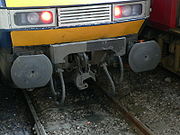
If worst comes to worst one might use a rope to join two wagons together, as might happen if one of the couplers breaks in service.
This formed a plot point in the British comedy film The Titfield Thunderbolt
The Titfield Thunderbolt
The Titfield Thunderbolt is a 1953 British comedy film about a group of villagers trying to prevent British Railways from closing the fictional Titfield branch line. The film was written by T.E.B...
, where a rope had to be used to connect a commandeered antique locomotive to its train. The rope subsequently snapped, leaving the train stranded.
Sets of carriages
Automatic couplers like the Janney are safer in a collision because they help prevent the carriages telescoping. British Rail therefore decided to adopt a Janney variant for its passenger carriages, with the coupler able to swing out of the way for coupling to engines with the traditional buffer and chain system.In New South Wales, sets of carriages were permanently coupled with a fixed bar, since the carriages were disconnected only at the workshops. Freight cars are sometimes coupled in pairs or triplets, using bar couplings in between.
Articulated
Articulated car
Articulated cars are rail vehicles which are consist of a number of smaller, lighter cars which are semi-permanently attached to each other and which share common trucks. They are much longer than single passenger cars, and on the TGV Réseau, for example, 8 cars are joined this way...
sets of carriages or wagons share the intermediate bogies
Jacobs bogie
Jacobs bogies are a type of rail vehicle bogie commonly found on articulated railcars and tramway vehicles....
, and have no need for couplings in the intermediate positions.
Coupler conversion
From time to time, a railway decides that it needs to upgrade its coupling system from one that is proving unsatisfactory, to another that meets future requirements. This can be done gradually, which can create lots of problems with transitional incompatibilities, or overnight, which requires a lot of planning.Japan
Japan converted its British-derived buffer and chain couplings to the American Janney coupling over a period of a few days in the early 1920s, after considerable preparation. Today, most (if not all) EMUsElectric multiple unit
An electric multiple unit or EMU is a multiple unit train consisting of self-propelled carriages, using electricity as the motive power. An EMU requires no separate locomotive, as electric traction motors are incorporated within one or a number of the carriages...
including high-speed Shinkansen
Shinkansen
The , also known as THE BULLET TRAIN, is a network of high-speed railway lines in Japan operated by four Japan Railways Group companies. Starting with the Tōkaidō Shinkansen in 1964, the network has expanded to currently consist of of lines with maximum speeds of , of Mini-shinkansen with a...
trains, and some DMUs
Diesel multiple unit
A diesel multiple unit or DMU is a multiple unit train consisting of multiple carriages powered by one or more on-board diesel engines. They may also be referred to as a railcar or railmotor, depending on country.-Design:...
use the Shaku-Thomlinson type coupling system, while locomotive-hauled trains use the Janney coupling and Tightlock coupling
Tightlock coupling
Tightlock coupling or titelok coupler is an Association of American Railroads tooth and toothbrush automatic coupler of which there are two types:...
system.
Australia
Australia, with its breaks of gauge, has always had different couplers on different systems, and has generally adopted gradual conversion. Conversion to the Janney coupling is now virtually complete. Commonwealth RailwaysCommonwealth Railways
The Commonwealth Railways were established in 1912, as part of a government department, currently called the Department of Infrastructure, Transport, Regional Development and Local Government, by the Government of Australia to construct the missing link in the east-west transcontinental railway and...
started with Janney couplings on its standard gauge
Standard gauge
The standard gauge is a widely-used track gauge . Approximately 60% of the world's existing railway lines are built to this gauge...
Trans-Australian line, and some railways, like the former Victorian Railways
Victorian Railways
The Victorian Railways operated railways in the Australian state of Victoria from 1859 to 1983. The first railways in Victoria were private companies, but when these companies failed or defaulted, the Victorian Railways was established to take over their operations...
and the Queensland Railways, used dual couplers. Older couplers remain on Heritage railways.
Europe
The European network has traditionally been formed of many independent national railway networks with buffer and chain used near universally to allow the interchange of rolling stock.The European Union Technical Specifications for Interoperability (TSIs) for high-speed passenger rolling stock mandate the use of Scharfenberg Type 10-compatible couplings. The Type 10 includes "horns" to aid coupling on curves and include a function to provide standardised automatic air-brake connections; the coupling horn is often visible poking out at the front of the nose of high-speed trains.
For European freight, the TSIs mandate buffer and chain couplings at specified heights. The European system links to the former Soviet Russian-gauge network, where SA3 automatic couplers are used. Some research has been undertaken to chose an automatic freight coupler compatible with the Soviet one, but owing to widescale replacement cost, no action has been taken to implement the conversion, except for some trial installations. In many heavy-haul applications, such as for coal and iron ore, either US AAR
Janney coupler
The Janney coupler, also known as a knuckle coupler, buckeye coupler, alliance coupler and AAR coupler is an automatic coupler patented by Eli H...
-type couplers or Soviet SA-3
SA3 coupler
The SA3 coupler is a type of railway coupling used mainly, but not exclusively, in Russia and other states of the former Soviet Union.Railways in Russia used European buffers and couplings from their inception. These couplings had three main limitations. Firstly the load was limited. Secondly, the...
couplers are used. Conversion is made harder to justify because the existing buffer and chain coupling is almost universal.
Meanwhile, drawgear of new rolling stock is being built at a height suitable for conversion. The proposed European freight coupling is compatible with the SA3 coupler
SA3 coupler
The SA3 coupler is a type of railway coupling used mainly, but not exclusively, in Russia and other states of the former Soviet Union.Railways in Russia used European buffers and couplings from their inception. These couplings had three main limitations. Firstly the load was limited. Secondly, the...
but adds integrated air and electrical connections. This standard would need to be revised to allow for the unforeseen development of electronically controlled pneumatic brakes
Electronically controlled pneumatic brakes
Electronically controlled pneumatic brakes are a type of modern railway braking system which offer improved performance compared to traditional pneumatic brakes.- Overview :...
.
United States
Once Congress passed the Safety Appliance Act mandating conversion from the link and pin coupler to the Janney coupler, railroads in the United States had only a few years to implement the change. The railroads in North America, except for mass transit, form one unitary system, and uniformity of couplers is important for smooth interchange of rolling stock.Latin America
Railways in Central and South America are fragmented by gauge, geography, and financial and technical heritage. While some systems have adopted the American Janney coupler, others retain the British buffer and hook (buffer and chain) coupler (see above).Soviet Union and successor states
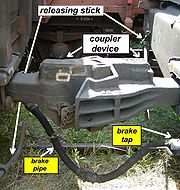
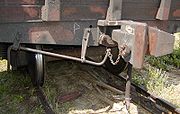
Russian Empire
The Russian Empire was a state that existed from 1721 until the Russian Revolution of 1917. It was the successor to the Tsardom of Russia and the predecessor of the Soviet Union...
and later Soviet Union
Soviet Union
The Soviet Union , officially the Union of Soviet Socialist Republics , was a constitutionally socialist state that existed in Eurasia between 1922 and 1991....
used buffer and chain couplings, albeit with possibly wider centres for the buffers, until conversion to automatic SA3 coupler
SA3 coupler
The SA3 coupler is a type of railway coupling used mainly, but not exclusively, in Russia and other states of the former Soviet Union.Railways in Russia used European buffers and couplings from their inception. These couplings had three main limitations. Firstly the load was limited. Secondly, the...
s. The SA3 coupler was invented in 1932. Some wagons were equipped with SA-3 couplers in the 1930s (they could be coupled with chain coupling), but all cars received automatic couplers in 1957.
Middle East
While the Middle East is mostly standard gauge, three different couplings appear to be in use (not counting Scharfenberg couplings on EMU trains). These are buffer-and-chain, American, and Russian types.Africa
South of the Sahara, Janney (AAR) and chopper couplings (not necessarily of compatible types) appear to account for most couplings. The preferred and proposed UAR standard is the American Janney (AAR) coupling.- Rail transport in GhanaRail transport in GhanaThe railway system in Ghana has historically been confined to the plains south of the barrier range of mountains north of the city of Kumasi. However, the narrow gauge railway, totalling 935 kilometres, is presently undergoing major rehabilitation and inroads to the interior are now being made...
Brake couplings
Couplings are needed for any continuous braking systems.Drawgear
Drawgear is structure that links the couplings at each end of the waggon to provide the strength needed to form trains. Early drawgear was make of wood, gradually being replaced by steel.Combined buffer-couplings have a centre sill to take the forces.
Buffers and chains tend to have the two buffers spaced according to the gauge.
Electronically controlled brakes
Electronically controlled pneumatic brakesElectronically controlled pneumatic brakes
Electronically controlled pneumatic brakes are a type of modern railway braking system which offer improved performance compared to traditional pneumatic brakes.- Overview :...
(ECP) need a method of connecting electrically adjacent wagons, both for power and for command signals, and this can be done by plugs and sockets, or by very short range radio signals.
Model trains
On model railroads couplers vary according to scale, and have evolved over many years. Early model trains were coupled using various hook-and-loop arrangements, which were frequently asymmetrical, requiring all cars to be pointing in the same direction. In the larger scales, working scale or near-scale models of Janney couplers were quite common, but proved impractical in HO and smaller scales.For many years, the "X2F" or "Horn-Hook" coupler was quite common in HO scale
HO scale
HO or H0 is the most popular scale of model railway in the world.According to the NMRA standard S-1.2 predominantly used in North America, in HO scale, represents 1 real foot ; this ratio works out to about 1:87.1. According to the MOROP standard NEM 010 predominantly used in Europe, the scale is...
, as it could be produced as a single piece of moulded plastic. Similarly, for many years, a "lift-hook" coupler known as the Rapido and developed by Arnold, a German manufacturer of N-scale
N scale
N scale is a popular model railway scale/track gauge. Depending upon the manufacturer , the scale ranges from 1:148 to 1:160. In all cases, the gauge is . The term N gauge refers to the track dimensions, but in the UK in particular N gauge refers to a 1:148 scale with track gauge modelling...
model trains, was commonly used in that scale.
The chief competitor of both these couplers, more popular among serious modellers, was the Magne-Matic, a magnetically-released knuckle coupler developed by Keith and Dale Edwards, and manufactured by Kadee
Kadee
Kadee Quality Products Co. is a model railroad manufacturer. They are best known for their couplers, but also produce rolling stock and accessories....
, a company they started. While they closely resemble miniature Janney couplers, they are somewhat different mechanically, with the knuckle pivoting from the center of the coupler head, rather than from the side. A steel pin, designed to resemble an air brake hose, allows the couplers to be released magnetically; the design of the coupler head prevents this from happening unless the train is stopped or reversed with a mated pair of couplers directly over an uncoupling magnet. An earlier, mechanically-tripped version of the design had a straight pin extending down from the knuckle itself, which engaged a diamond-shaped mechanical "ramp" between the rails, which had to be raised above rail height when uncoupling was desired.
Once the Kadee patents ran out, a number of other manufacturers began to manufacture similar (and compatible) magnetic knuckle couplers.
Recently, an exact-scale HO model of the AAR coupler has been designed and manufactured by Frank Sergent, of Sergent Engineering. This design uses a tiny stainless steel ball to lock the knuckle closed. Uncoupling is achieved by holding a magnetic wand over the coupler pair to draw the balls out of the locking pockets.
In O scale
O scale
O scale is a scale commonly used for toy trains and model railroading. Originally introduced by German toy manufacturer Märklin around 1900, by the 1930s three-rail alternating current O gauge was the most common model railroad scale in the United States and remained so until the early 1960s...
, an exact-scale working miniature version of the "Alliance" coupler was manufactured from the 1980s by GAGO models in Australia. Since 2002 it has been marketed by the Waratah Model Railway Company European modellers tend to use scale hook and chain couplings.
In British 00 scale (similar to H0 scale) models the 'tension lock' coupler developed by Tri-ang is standard. This is similar in operation to the meatchopper type of coupling. Remote uncoupling is possible by using a sprung ramp between the rails. By halting the train over the ramp, it is split at this point. While it works well, it is often seen as ugly and obtrusive (although smaller designs are available, these are not always fully compatible with other models) and many British modellers prefer to retrofit either Kadee types or working hook and chain couplings.
A recent development is an interchangeable coupling which plugs into a standardised socket, known as NEM 362 and which can be easily unplugged as required. This allows the modeller to easily standardise on whatever coupling is desired, without individual manufacturers needing to change their coupling type.
For a comparison of coupler types see
Accidents
Different kinds of coupling have different accident rates.- UK 1906 - twelve fatal and 523 non-fatal accidents
- The Murulla rail accidentMurulla rail accidentThe Murulla rail accident involved the collision of the Sydney-bound Northwest Mail Train with runaway goods wagons near Murrurundi, New South Wales, in the Upper Hunter Valley on 13 September 1926...
of 1926 involved the breakage of a "drawhook" leading to a runaway and then a collision. Drawhooks imply "buffers and screw" couplings.
- Round Oak - 1858 - coupling broke and rear of train rolled back.
See also
- Corridor connectionCorridor connectionA Corridor connection is a flexible connector fitted to the end of a railway coach to enable passage from one coach to another without falling out of the train.-Coaches:...
- Coupling (railway) by countryCoupling (railway) by countryCoupling by country generally list the main national system and exclude minor narrow gauge or industrial lines of short length. Modern EMU or DMU passenger vehicles are also excluded...
- Buckeye Steel CastingsBuckeye Steel CastingsBuckeye Steel Castings was a Columbus, Ohio steelmaker best known today for its longtime president, Samuel P. Bush, who was the grandfather of President George H.W. Bush and great-grandfather of President George W. Bush....
- South Station (Boston)South Station (Boston)South Station, New England's second-largest transportation center , located at the intersection of Atlantic Avenue and Summer Street in Dewey Square, Boston, Massachusetts, is the largest train station and intercity bus terminal in Greater Boston, a prominent train station in the northeastern...
, includes a sculpture built of railroad car couplers
Sources
- Norfolk & Western Railway Co. v. Hiles (95-6), 516 U.S. 400 (1996) (U.S. Supreme Court decision by Justice Clarence ThomasClarence ThomasClarence Thomas is an Associate Justice of the Supreme Court of the United States. Succeeding Thurgood Marshall, Thomas is the second African American to serve on the Court....
) - Eli Janney — The Janney Coupler (based on above case)
- Dellner Couplers AB — Automatic and Semi-Permanent Couplers
- Vancouver SkyTrain Light Rail Network, Canada (these two for Dellner data)
- JANE'S WORLD RAILWAYS
- How couplings work
- White, John H. Jr, The American Railroad Passenger Car (1978), Chapter 7. ISBN 0-8018-1965-2 (hardcover), ISBN 0-8018-2743-4 (paperback, two-volume set—Chapter 7 is in Volume 2)
External links
- West Somerset Railway - Feature: Couplings – Descriptions of: three-link, Instanter, Screw, Buckeye
- ASF Keystone, Inc.
- A history of the automatic coupler
- Janney Coupler
- A.B.C. Coupler Ltd.
- McConway & Torley Group
- Dellner Couplers Group
- Scharfenberg couplers
- Braithwaite (India) couplers
- Stäubli couplings
- Image of a Tomlinson coupler
- Intermat/Willison coupler
- Willison
- Setesdalsbanen - Many picture of Norwegian (chopper) coupler) Animation showing SA3 coupling
- Egyptian loco with CBC and buffers removed
- Egyptian loco with buffers and screw coupling H*D signal
- Knorr-Bremse Unicoupler
- Unicoupler text

